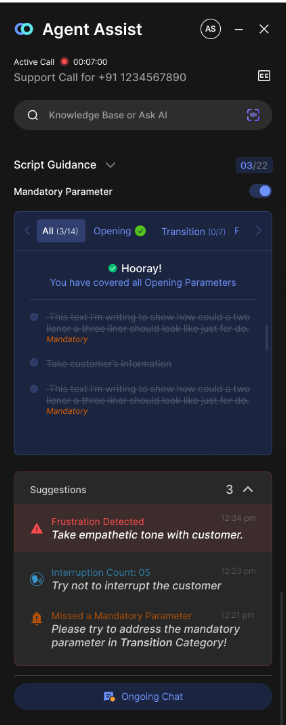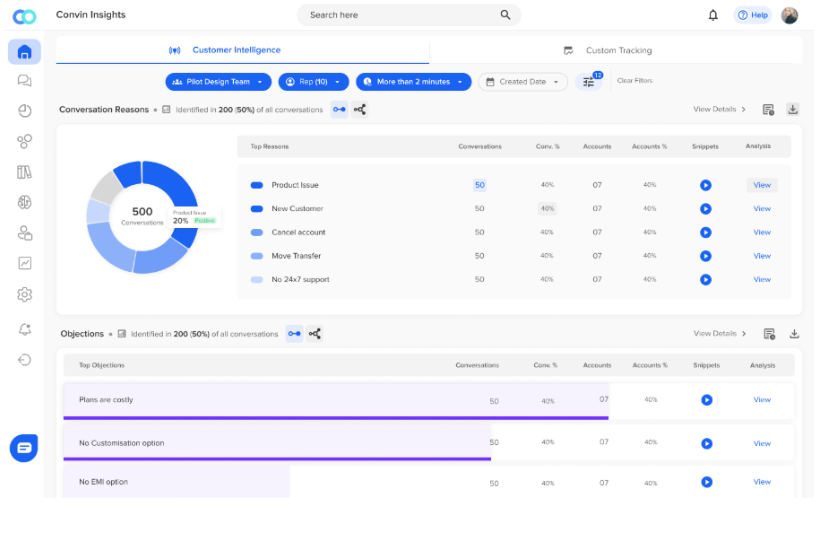In 2025, insurance call centers are poised for a major transformation, and the driving force behind this shift is generative AI. No longer just a buzzword, this technology is revolutionizing how insurers engage with customers, enhance operational efficiency, and ensure compliance.
By incorporating real-time intelligence and predictive capabilities, generative AI is becoming a vital tool for modernizing customer support in the insurance industry.
In this blog, we’ll dive deep into how generative AI is powering the next era of insurance call centers. From real-time compliance monitoring and automated agent coaching to AI-driven call summaries and conversation intelligence, this post will explore the wide-reaching benefits of AI for both insurers and customers.
Plus, discover how Convin’s Voice Bot is leading the charge in providing smarter, more efficient customer experiences. Ready to see how this AI revolution can elevate your insurance call center? Read on to uncover the details.
Explore how Convin’s generative AI is transforming insurance call centers
What’s Really Changing Inside Insurance Call Centers
Generative AI isn’t a buzzword anymore, it’s becoming the backbone of modern insurance call centers. This shift isn’t just about automation; it’s about real-time intelligence, continuous learning, and risk mitigation.
In 2025, the call center will become the nerve center of customer trust, and generative AI is its central processor.
1. What Generative AI Brings To Modern Insurance Call Centers
At its core, generative AI ingests language, patterns, and context, then crafts responses, insights, or alerts dynamically. In insurance call centers, this means going beyond scripted chatbots to models that understand policy nuances, regulatory guardrails, and customer intent in the moment.
- It can generate call summaries, synthesize insights, or draft replies mid-call.
- It can flag compliance violations using pattern detection.
- It can propose the next-best-action prompts or upsell ideas relevant to policy data.
By overlaying policy logic, regulatory rules, and conversational intelligence, generative AI becomes more than automation, it becomes a real-time collaborator for agents.
2. Why 2025 Is The Defining Year For AI In Insurance
2025 is that inflection point where underlying tech (LLMs, real-time speech AI), regulatory clarity, and executive urgency align. The market expects adoption and payoff, not experimentation.
- The global call center AI market was valued at USD 2.1 billion in 2024 and is projected to grow at ~18.9% CAGR through 2034.
- This is backed by some other reports which place similar growth ranges: USD 1.95B in 2024 to USD 10.07B by 2032 (CAGR ~22.7%)
- Meanwhile, 65% of call center interactions are now reportedly handled by AI‐driven solutions in many centers.
This is the moment when generative AI shifts from pilot to baseline, insurers not deploying it risk being left behind operationally and competitively.
3. Shifting From Reactive To Predictive Service Models
Traditional call centers operate reactively: calls come in, and agents respond based on the immediate need. However, generative AI enables a shift towards predictive call center operations.
Instead of just responding to issues, AI can anticipate customer intent and suggest proactive solutions before problems escalate.
For example, AI can detect early signs of dissatisfaction, such as phrases like "I might cancel," during a call, and immediately suggest retention scripts for agents to use.
Additionally, predictive routing allows AI to direct calls to agents who are specifically trained to handle certain policy types or sensitive issues, improving both efficiency and outcomes.
Furthermore, after a call, AI can automatically flag follow-up actions or identify cross-sell opportunities, ensuring no chance is missed before the next customer interaction.
As call centers evolve, the focus shifts from merely solving past problems to proactively guiding future interactions. Generative AI serves as the engine driving this transformation, enabling call centers to stay ahead of customer needs.
Now that we’ve established why generative AI is now essential, let’s dig deeper into how it powers the three critical pillars of a modern insurance call center: compliance, coaching, and transcripts.
Discover the role of AI in boosting customer satisfaction with Convin
Generative AI for Compliance, Coaching, and Call Transcripts
Insurance is among the most regulated industries. Every agent phrase, every upsell, every promise must be compliant. Generative AI steps in not as a passive tool, but as an active guardian, continuously parsing conversations, shaping coaching, and ensuring transcripts are accurate and actionable.
1. Real-Time Compliance Monitoring To Reduce Risk
Compliance violations can cost millions and erode trust. Traditional methods, post-call audits and manual checks, are reactive and slow. Generative AI enables real-time compliance monitoring: instant alerts, policy checks, and intervention.
- AI can flag “forbidden phrases” (e.g. mis-selling, overpromising) as they emerge.
- Violation alerts can surface to supervisors who may barge-in or correct mid-call.
- It ensures adherence to scripts mandated by law or internal governance.
Real-time compliance is no longer aspirational, it's imperative. With generative AI watching every word, insurers can detect and correct before breaches escalate.
2. AI-Generated Call Summaries And Accurate Transcripts
Transcripts in call centers should go beyond simple call logs; they need to become actionable narratives that capture sentiment, intent, and key insights.
Generative AI is capable of automating this process by synthesizing conversations and tagging important themes as they unfold.
For instance, AI models can generate concise call summaries, such as "The customer inquired about policy renewal, and the agent provided available options."
Beyond summaries, AI can annotate transcripts with additional context, including sentiment analysis, compliance flags, and recommended next steps for agents. These AI-generated insights also play a crucial role in quality assurance (QA), audits, and data aggregation for deeper analytics.
By structuring conversations into meaningful data, they support continuous improvement and informed decision-making across the business.
When transcripts evolve from raw text into structured insights, call centers gain unprecedented clarity.
Every interaction becomes a valuable data point that drives continuous operational enhancement, ensuring higher quality service and better outcomes for both agents and customers.
3. Automated Coaching And Skill Development For Agents
Agent coaching has traditionally been periodic and labor-intensive. Generative AI enables ongoing, contextual coaching, suggestions during calls and tailored learning loops after calls.
- During a call, agents can receive context-aware prompts (e.g. “offer fallback plan X”).
- After calls, AI can generate mini coaching tips: strengths, improvement areas, micro-learning paths.
- Onboarding accelerates: AI can simulate customer scenarios and provide feedback.
Instead of waiting for weekly reviews, agents get feedback in the flow, raising skill levels faster and more consistently.
With those pillars in place, the question becomes: what anchors the entire intelligence stack? Enter Convin’s Voice Bot and its broader AI suite, the front-line, integrated engine powering call centers of 2025.
Get real-time coaching for agents with Convin’s generative AI solutions
This blog is just the start.
Unlock the power of Convin’s AI with a live demo.

Convin’s AI: Voice Bot And Conversation Intelligence for InsurTech
Convin doesn’t just supply AI modules, it positions the voice bot as the front line of conversation automation, backed by real-time assist and feedback loops. This architecture ensures every call is served, guided, audited, and optimized.
1. Convin Voice Bot: The First Line Of Intelligent Call Handling
The Convin voice bot stands at the call entry point, handling routine queries, routing complex ones, and gathering contextual data upfront.
- It can answer common requests (e.g. “What’s my premium?”), freeing agents for high-value work.
- It seamlessly hands over to live agents when escalation or human empathy is needed.
- It feeds context and transcript to downstream modules (assist, intelligence, coaching).
By making the bot the first contact, Convin ensures consistent service, calls routed smartly, and agents enter with full context.

2. Real-Time Agent Assist For Contextual, On-Call Guidance
Once a live agent is in the loop, Convin’s real-time agent assist intervenes, supplying prompts, legal guardrails, and knowledge integration, all anchored by generative AI.
- Agents resolve issues 25% faster using real-time suggestions.
- Convin’s real-time module supports “Ask AI,” dynamic battlecards, and contextual prompts.
- It aids compliance, upselling, and first-call resolution while lowering after-call work.
In effect, Agent Assist becomes the real-time co-pilot, never distracted, always context-aware, reducing error and boosting speed.

3. Contact Center Conversation Intelligence For Continuous Learning
Underneath every call lies a web of insights, customer intent, friction points, topic clusters. Convin’s Conversation Intelligence applies generative AI to drive continuous improvement.
- It indexes conversations, surfaces patterns, and spots systemic issues.
- It feeds models for predictive call routing, customer sentiment scoring, and agent benchmarking.
- It enables aggregation: “What product type causes the most confusion?” or “Where do agents deviate most often?”
With intelligence baked into every call, the call center becomes a learning organism, diagnosing itself and optimizing continuously.
4. Voice Of Customer Software For Measuring Policyholder Experience
Customer satisfaction is not just a metric, it’s the mission. Convin’s voice of customer software captures feedback, sentiment, and emergent themes across calls.
- It pulls from transcripts, surveys, and sentiment tags.
- It segments feedback by policy type, agent, or issue type.
- It maps experience gaps and surfaces suggestions for operations, product, or agent training.
Instead of guessing what customers feel, insurance leaders see it in data, and act with precision.
We’ve gone deep into architecture. But what really matters to executives is impact. Let’s zoom into the top benefits, the ones boardrooms care about.
Unlock the power of Convin’s Voice Bot for smarter call handling
Top Benefits Of Generative AI In Insurance Call Centers
Here are the compelling, must-know business outcomes when generative AI powers your call center, especially in insurance, where margins are tight and expectations are high.
- Faster response times and reduced AHT (Average Handle Time)
- Consistent compliance and lower QA / audit costs
- Improved CSAT and policyholder trust
- Personalized call flows using AI-driven insights
- Automated insurance call handling even for complex queries
- Enhanced agent productivity through AI-driven coaching
These benefits aren’t theoretical; they’re already emerging in modern deployments. For insurance call centers in 2025, generative AI is the differentiator between laggards and leaders.
We’ve mapped the architecture, benefits, and evidence. Let’s close with a look toward what lies ahead, and how Convin positions itself at the center of that future.
Boost agent productivity with Covin’s AI-driven real-time suggestions
The Future Of AI-Driven Customer Support In Insurance
In 2025, generative AI will be the driving force behind the transformation of insurance call centers. By enabling real-time intelligence, predictive service models, and continuous learning, it empowers call centers to improve compliance, agent productivity, and customer satisfaction.
AI will go beyond automating tasks, it will become a core collaborator, guiding agents with the right insights at the right time.
The integration of advanced AI technologies like Convin's Voice Bot and Conversation Intelligence allows insurers to not only meet customer needs but also anticipate them. This shift from reactive to proactive service will redefine the insurance industry, enhancing both operational efficiency and customer experience.
As the future unfolds, those who embrace generative AI in their call center strategies will lead the way, staying ahead of competitors and driving long-term growth.
Ready to enhance your insurance call center with AI-driven solutions? Contact us today to learn how Convin can help you achieve these transformations.
FAQ
1. What are the benefits of generative AI for the insurance industry?
Generative AI enhances the insurance industry by automating routine tasks, improving compliance monitoring, offering personalized customer interactions, and streamlining agent performance. It can analyze conversations in real-time, provide agents with context-aware prompts, and assist with decision-making. Convin’s AI solutions, like its voice bot and conversation intelligence, help insurers reduce costs while boosting customer satisfaction.
2. Is AI going to replace call centers?
AI will not replace call centers but will revolutionize them. Generative AI can handle routine inquiries, allowing agents to focus on complex issues and enhance customer relationships. By integrating AI tools like Convin’s voice bot, call centers can provide smarter, faster service while maintaining human empathy when necessary.
3. What are the benefits of generative AI in customer service?
Generative AI boosts customer service by offering faster responses, more accurate information, and personalized experiences. It helps agents by providing real-time suggestions, improving training with continuous feedback, and ensuring compliance. AI can also analyze customer sentiment, leading to proactive resolutions and a better overall service experience.
4. How will AI impact the insurance industry?
AI will drive innovation in the insurance industry by automating processes, enhancing customer experience, improving fraud detection, and optimizing claims processing. With AI, insurers can offer personalized policies, automate routine tasks, and reduce operational costs. Generative AI tools, like Convin's AI suite, enable insurance companies to stay competitive in an increasingly digital landscape.
5. How can generative AI help in reducing customer churn?
Generative AI helps reduce customer churn by anticipating issues before they escalate. It can flag dissatisfied customers during interactions, suggest retention strategies, and improve agent responses with real-time coaching. With tools like Convin's Voice Bot, AI analyzes customer sentiment and automates proactive outreach, improving customer retention and satisfaction.










.avif)